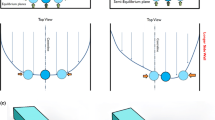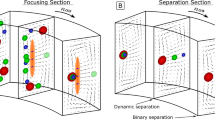Abstract
Inertial microfluidics has become one of the emerging topics due to potential applications such as particle separation, particle enrichment, rapid detection and diagnosis of circulating tumor cells. To realize its integration to such applications, underlying physics should be well understood. This study focuses on particle dynamics in curvilinear channels with different curvature angles (280°, 230°, and 180°) and different channel heights (90, 75, and 60 µm) where the advantages of hydrodynamic forces were exploited. We presented the cruciality of the three-dimensional particle position with respect to inertial lift forces and Dean drag force by examining the focusing behavior of 20 µm (large), 15 µm (medium) and 10 µm (small) fluorescent polystyrene microparticles for a wide range of flow rates (400–2700 µL/min) and corresponding channel Reynolds numbers. Migration of the particles in lateral direction and their equilibrium positions were investigated in detail. In addition, in the light of our findings, we described two different regions: transition region, where the inner wall becomes the outer wall and vice versa, and the outlet region. The maximum distance between the tight particle stream of 20 and 15 µm particles was obtained in the 90 high channel with curvature angle of 280° at Reynolds number of 144 in the transition region (intersection of the turns), which was the optimum condition/configuration for focusing.








Similar content being viewed by others
References
Amini H, Lee W, Di Carlo D et al (2014) Inertial microfluidic physics. Lab Chip 14:2739–2761. https://doi.org/10.1039/c4lc00128a
Asmolov EES (1999) The inertial lift on a spherical particle in a plane Poiseuille flow at large channel Reynolds number. J Fluid Mech 381:63–87. https://doi.org/10.1017/S0022112098003474
Bhagat AAS, Kuntaegowdanahalli SS, Papautsky I (2008) Continuous particle separation in spiral microchannels using dean flows and differential migration. Lab Chip 8:1906. https://doi.org/10.1039/b807107a
Bhagat AAS, Kuntaegowdanahalli SS, Papautsky I (2009) Inertial microfluidics for continuous particle filtration and extraction. Microfluid Nanofluidics 7:217–226. https://doi.org/10.1007/s10404-008-0377-2
Bhagat AAS, Bow H, Hou HW et al (2010) Microfluidics for cell separation. Med Biol Eng Comput 48:999–1014. https://doi.org/10.1007/s11517-010-0611-4
Chen Y, Li P, Huang P-H et al (2014a) Rare cell isolation and analysis in microfluidics. Lab Chip 14:626. https://doi.org/10.1039/c3lc90136j
Chen Y, Nawaz AA, Zhao Y et al (2014b) Standing surface acoustic wave (SSAW)-based microfluidic cytometer. Lab Chip 14:916–923. https://doi.org/10.1039/C3LC51139A
Cherukat P, McLaughlin JBB, Dandy DSS (1999) A computational study of the inertial lift on a sphere in a linear shear flow field. Int J Multiph Flow 25:15–33. https://doi.org/10.1016/S0301-9322(98)00034-2
Destgeer G, Ha BH, Park J et al (2015) Microchannel anechoic corner for size-selective separation and medium exchange via traveling surface acoustic waves. Anal Chem 87:4627–4632. https://doi.org/10.1021/acs.analchem.5b00525
Di Carlo D (2009) Inertial microfluidics. Lab Chip 9:3038–3046. https://doi.org/10.1039/b912547g
Di Carlo D, Irimia D, Tompkins RG, Toner M (2007) Continuous inertial focusing, ordering, and separation of particles in microchannels. Proc Natl Acad Sci USA 104:18892–18899. https://doi.org/10.1073/pnas.0704958104
Di Carlo D, Edd JF, Irimia D et al (2008) Equilibrium separation and filtration of particles using differential inertial focusing. Anal Chem 80:2204–2211. https://doi.org/10.1021/ac702283m
Di Carlo D, Edd JF, Humphry KJ et al (2009) Particle segregation and dynamics in confined flows. Phys Rev Lett 102:94503. https://doi.org/10.1103/PhysRevLett.102.094503
Fan LL, Han Y, He XK et al (2014) High-throughput, single-stream microparticle focusing using a microchannel with asymmetric sharp corners. Microfluid Nanofluidics 17:639–646. https://doi.org/10.1007/s10404-014-1344-8
Gossett DR, Di Carlo D, Carlo D Di (2009) Particle focusing mechanisms in curving confined flows. Anal Chem 81:8459–8465. https://doi.org/10.1021/ac901306y
Guan G, Wu L, Bhagat AAA et al (2013) Spiral microchannel with rectangular and trapezoidal cross-sections for size based particle separation. Sci Rep 3:1475. https://doi.org/10.1038/srep01475
Hejazian M, Li W, Nguyen N-T (2015) Lab on a chip for continuous-flow magnetic cell separation. Lab Chip 15:959–970. https://doi.org/10.1039/C4LC01422G
Hyun K-A, Jung H-I (2014) Advances and critical concerns with the microfluidic enrichments of circulating tumor cells. Lab Chip 14:45–56. https://doi.org/10.1039/C3LC50582K
Jubery TZ, Srivastava SK, Dutta P (2014) Dielectrophoretic separation of bioparticles in microdevices: a review. Electrophoresis 35:691–713. https://doi.org/10.1002/elps.201300424
Jung W, Han J, Choi J-WW, Ahn CH (2015) Point-of-care testing (POCT) diagnostic systems using microfluidic lab-on-a-chip technologies. Microelectron Eng 132:46–57. https://doi.org/10.1016/j.mee.2014.09.024
Kim SB, Yoon SY, Jin Sung H, Kim A SS (2008) Cross-type optical particle separation in a microchannel. Anal Chem 80:2628–2630. https://doi.org/10.1021/AC8000918
Kirby D, Siegrist J, Kijanka G et al (2012) Centrifugo-magnetophoretic particle separation. Microfluid Nanofluidics 13:899–908. https://doi.org/10.1007/s10404-012-1007-6
Kuntaegowdanahalli SSSS., Bhagat AAAS., Kumar G, Papautsky I (2009) Inertial microfluidics for continuous particle separation in spiral microchannels. Lab Chip 9:2973. https://doi.org/10.1039/b908271a
Lenshof A, Laurell T (2010) Continuous separation of cells and particles in microfluidic systems. Chem Soc Rev 39:1203. https://doi.org/10.1039/b915999c
Li S, Ren L, Huang P-H et al (2016) Acoustofluidic transfer of inflammatory cells from human sputum samples. Anal Chem 88:5655–5661. https://doi.org/10.1021/acs.analchem.5b03383
Martel JM, Toner M (2012) Inertial focusing dynamics in spiral microchannels. Phys Fluids 24:32001. https://doi.org/10.1063/1.3681228
Martel JMJ, Toner M (2013) Particle focusing in curved microfluidic channels. Sci Rep 3:1–8. https://doi.org/10.1038/srep03340
Martel JM, Toner M (2014) Inertial focusing in microfluidics. Annu Rev Biomed Eng 16:371–396. https://doi.org/10.1146/annurev-bioeng-121813-120704
Matas JJ-P, Morris JJF, Guazzelli É et al (2004) Inertial migration of rigid spherical particles in Poiseuille flow. J Fluid Mech 515:171–195
Modak N, Datta A, Ganguly R (2009) Cell separation in a microfluidic channel using magnetic microspheres. Microfluid Nanofluidics 6:647–660. https://doi.org/10.1007/s10404-008-0343-z
Mu X, Zheng W, Sun J et al (2013) Microfluidics for manipulating cells. Small 9:9–21. https://doi.org/10.1002/smll.201200996
Myung JH, Hong S (2015) Microfluidic devices to enrich and isolate circulating tumor cells. Lab Chip 15:4500–4511. https://doi.org/10.1039/C5LC00947B
Oakey J, Applegate RW, Arellano E et al (2010) Particle focusing in staged inertial microfluidic devices for flow cytometry. Anal Chem 82:3862–3867. https://doi.org/10.1021/ac100387b
Özbey A, Karimzadehkhouei M, Akgönül S et al (2016) Inertial focusing of microparticles in curvilinear microchannels. Sci Rep 6:1–11. https://doi.org/10.1038/srep38809
Pamme N (2007) Continuous flow separations in microfluidic devices. Lab Chip 7:1644–1659. https://doi.org/10.1039/b712784g
Park JS, Jung H (2009) Multiorifice flow fractionation: continuous size-based separation of microspheres using a series of contraction/expansion microchannels. Anal Chem 81:8280–8288. https://doi.org/10.1021/ac9005765
Pratt ED, Huang C, Hawkins BG et al (2011) Rare cell capture in microfluidic devices. Chem Eng Sci 66:1508–1522. https://doi.org/10.1016/j.ces.2010.09.012
Russom A, Gupta AK, Nagrath S et al (2009) Differential inertial focusing of particles in curved low-aspect-ratio microchannels. New J Phys 11:1–9. https://doi.org/10.1088/1367-2630/11/7/075025
Sackmann EKE, Fulton AAL, Beebe DDJ (2014) The present and future role of microfluidics in biomedical research. Nature 507:181–189. https://doi.org/10.1038/nature13118
Sajeesh P, Sen AK (2013) Particle separation and sorting in microfluidic devices: a review. Microfluid Nanofluidics 17:1–52. https://doi.org/10.1007/s10404-013-1291-9
Schonberg JA, Hinch EJ (1989) Inertial migration of a sphere in Poiseuille flow. J Fluid Mech 203:517–524. https://doi.org/10.1017/S0022112089001564
Segre G, Silberberg A (1962a) Behaviour of macroscopic rigid spheres in Poiseuille flow Part 1. Determination of local concentration by statistical analysis of particle passages through crossed light beams. J Fluid Mech 14:115. https://doi.org/10.1017/S002211206200110X
Segre G, Silberberg A (1962b) Behaviour of macroscopic rigid spheres in Poiseuille flow Part 2. Experimental results and interpretation. J Fluid Mech 14:136. https://doi.org/10.1017/S0022112062001111
Sim TS, Kwon K, Park JC et al (2011) Multistage-multiorifice flow fractionation (MS-MOFF): continuous size-based separation of microspheres using multiple series of contraction/expansion microchannels. Lab Chip 11:93–99. https://doi.org/10.1039/c0lc00109k
Trabzon L, Kizil H, Yobas L et al (2011) The Effect of asymmetry on particle focusing in microchannels. Adv Mater Res 403–408:482–485. https://doi.org/10.4028/www.scientific.net/AMR.403-408.482
Wang X, Zandi M, Ho C-C et al (2015) Single stream inertial focusing in a straight microchannel. Lab Chip 15:1812–1821. https://doi.org/10.1039/c4lc01462f
Wyatt Shields IVC, Reyes CD, Lopez GP (2015) Microfluidic cell sorting: a review of the advances in the separation of cells from debulking to rare cell isolation. Lab Chip 15:1230–1249. https://doi.org/10.1039/C4LC01246A
Xiang N, Chen K, Dai Q et al (2014) Inertia-induced focusing dynamics of microparticles throughout a curved microfluidic channel. Microfluid Nanofluidics 18:29–39. https://doi.org/10.1007/s10404-014-1395-x
Xuan X, Zhu J, Church C (2010) Particle focusing in microfluidic devices. Microfluid Nanofluidics 9:1–16. https://doi.org/10.1007/s10404-010-0602-7
Yoon DH, Ha JB, Bahk YK et al (2009) Size-selective separation of micro beads by utilizing secondary flow in a curved rectangular microchannel. Lab Chip 9:87–90. https://doi.org/10.1039/b809123d
Zhang J, Yan S, Sluyter R et al (2014) Inertial particle separation by differential equilibrium positions in a symmetrical serpentine micro-channel. Nat Sci Reports 4:1–9. https://doi.org/10.1038/srep04527
Zhang J, Yan S, Yuan D et al (2016) Fundamentals and applications of inertial microfluidics: a review. Lab Chip 16:10–34. https://doi.org/10.1039/C5LC01159K
Zhou J, Kasper S, Papautsky I (2013) Enhanced size-dependent trapping of particles using microvortices. Microfluid Nanofluidics 15:611–623. https://doi.org/10.1007/s10404-013-1176-y
Zhu J, Tzeng T-RJ, Hu G, Xuan X (2009) DC dielectrophoretic focusing of particles in a serpentine microchannel. Microfluid Nanofluidics 7:751–756. https://doi.org/10.1007/s10404-009-0432-7
Acknowledgements
The authors thank Mr. Rohan Vernekar from the University of Edinburgh, Mr. Süleyman Çelik and Mr. Hasan Özkaya from Sabanci University Nanotechnology Research and Applications Center (SUNUM), Dr. Batu Erman’s and Dr. Devrim Gözüaçık’s group members from Sabanci University Molecular Biology, Genetics and Bioengineering Program, and Mr. Hossein Alijani from Sabanci University, Mechatronics Program for their suggestions and fruitful discussions, and Mr. İrfan Demircioğlu, undergraduate student from Sabanci University, for his help in performing some of the simulations. The equipment and characterization support provided by the Sabancı University Nanotechnology Research and Applications Center (SUNUM) is appreciated. This work was supported by the Sabanci University Internal Research Grant No. IACF15-1444, Science Academy Outstanding Young Investigator Support Program (BAGEP), Turkish Academy of Science (TUBA) and Outstanding Young Investigator Support Program (GEBIP).
Author information
Authors and Affiliations
Corresponding author
Additional information
Publisher’s Note
Springer Nature remains neutral with regard to jurisdictional claims in published maps and institutional affiliations.
Electronic supplementary material
Below is the link to the electronic supplementary material.
10404_2018_2082_MOESM1_ESM.doc
Focusing position intensity graph exporting sample; diagram of forces acting on microparticles; focusing of 15 µm particles at different transition regions along the channel, focusing streak positions of particles for 230° and 180° curvature angle designs in the transition and/or outlet regions; overlaid channel Reynolds number maps; simulated velocity profiles (DOC 2676 KB)
Rights and permissions
About this article
Cite this article
Özbey, A., Karimzadehkhouei, M., Bayrak, Ö. et al. Inertial focusing of microparticles in curvilinear microchannels with different curvature angles. Microfluid Nanofluid 22, 62 (2018). https://doi.org/10.1007/s10404-018-2082-0
Received:
Accepted:
Published:
DOI: https://doi.org/10.1007/s10404-018-2082-0




